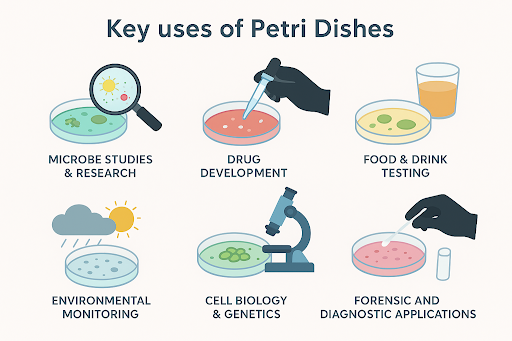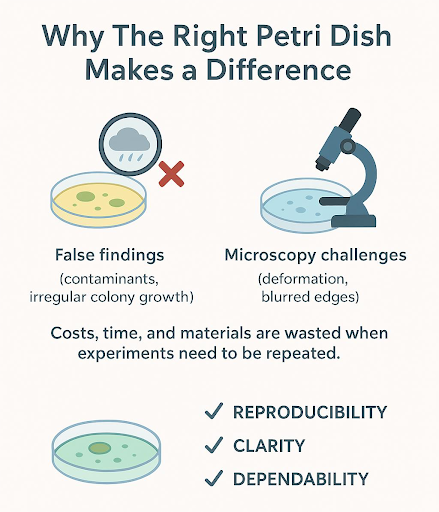Many people are unaware of how much can be learned about petri dishes, despite the fact that they are essential in industrial labs, biology, and diagnostics. This guide will explain what a petri dish is?, how and why it is used?, learn about important characteristics that affect results, best practices for using it, and how AHN myPlate® petri dishes can satisfy the most meticulous laboratory requirements.
What is a Petri Dish?
A petri dish is a lab consumable, typically round, that is made of glass or plastic, used for growing microbial culture, and has a lid to avoid cross-contamination. Its primary purpose is to hold growth media, like agar, which enables the growth & proliferation of cells, microbes, or small organisms under controlled conditions.
Petri dishes were first introduced/ invented in 1887 by the German bacteriologist Julius Richard Petri, and are now essential tools in a variety of fields, including environmental science, cell biology, and microbiology. Numerous diagnostics instruments, vaccine advancements, and research procedures would not be possible without them.
Key Uses of Petri Dishes
Petri dishes are versatile. Here are some of the main ways labs and researchers use them:
- Microbe Studies & Research: Scientists still prefer petri dishes to isolate, identify, and examine bacterial, fungal, and yeast groups. Their controlled surface lets researchers watch growth patterns, colony shapes, and how organisms interact.
- Drug Development: From finding new antibiotics to making vaccines, petri dishes serve as the base to test how well drugs work and if microbes resist them.
- Food & Drink Testing: Quality teams in the food business count on petri dishes to look for contamination, making sure products are safe and follow the rules.
- Environmental Monitoring: Scientists use petri dishes to grow samples from air, soil, and water. This helps them check for microbes, spot pollutants, or keep an eye on cleanliness in sterile rooms and hospitals.
- Cell Biology & Genetics: Petri dishes do more than just handle microbes. Researchers adapt them to culture bigger cells, watch how cells act, or run tests on genes.
Forensic and Diagnostic Applications: Crime labs and medical centers rely on petri dishes for tests. These tests help pinpoint germs, find where contamination started, or aid in figuring out diseases.
At its core, petri dishes connect basic research, practical science, and industrial testing. This makes them some of the most adaptable supplies you’ll find in any lab.
What to Consider When Choosing Petri Dishes
Not all petri dishes are the same. If you are selecting petri dishes for your lab, here are some critical features and criteria.
| Feature | Why It Matters |
| Material | Although glass is more fragile and heavier, it is reusable, autoclavable, and resistant to many chemicals. Dishes made of plastic, usually polystyrene or polypropylene, are portable, easy to throw away, and lightweight. |
| Sterility | Dishes that are sterile lower the chances of contamination. Sterile, individually wrapped dishes are useful when performing precise assays or using sterile growth medium. |
| Clarity and optical grade | Clarity is important when examining colonies, cell morphology, or under a microscope. High optical quality plastic glass helps with visibility. |
| Size and shape | Commonly used round dishes measure 90 to 100mm, but for specific uses, you might need square dishes, petri dishes with grid markings or smaller plates for specialised applications. |
| Lid fit & sealing | To keep out impurities, you need a tight-fitting lid that allows some gas exchange. Some designs have locking mechanisms or vented lids, while others stack nicely. |
| Sterilization method | Glass petri plates can be autoclaved for reuse, while Accumax plastic plates are gamma sterilized in-house up to SAL 10-6, ensuring they are pre-sterilized, contamination-free, and ready to use. |
| Cost & waste considerations | Glass dishes are reusable and provide excellent visibility under a microscope, but require careful handling to prevent breakage. Plastic Petri dishes are disposable, offering convenience and minimizing contamination risks during experiments. |
Introducing AHN myPlate® Petri Dishes
When you are looking for reliable, high-quality petri dishes tailored for demanding lab work, AHN Biotechnology Pvt Ltd offers the AHN myPlate® Petri Dishes.
AHN myPlate® Petri Dishes:
Users who demand precise dimensions, consistent surface quality, and exceptional clarity will be directly attracted towards the AHN myPlate® Petri Dishes. These petri dishes are best for:
- Examining colonies or cell cultures under a microscope, where optical quality is crucial.
- Research settings or educational labs where visual accuracy and repeatability are crucial.
- Tests and assays where the consistency of the agar surface is important to prevent morphology that is misleading or growth that is not uniform.
These dishes are gamma sterilised and constructed from high-quality plastic. The base has flat bottoms for even spreading, and the lids are designed to minimise condensation. myPlate® is a great option if you need a petri dish that consistently produces dependable, clean results.
Why The Right Petri Dish Makes a Difference
Selecting a subpar dish, such as one with an uneven bottom, poor clarity, or improperly sealed lids, can result in:
- False findings (contaminants, irregular colony growth)
- Microscopy challenges (deformation, blurred edges)
- Costs, time, and materials are wasted when experiments need to be repeated.
Reproducibility, clarity, and dependability are advantages that labs enjoy when using premium petri dishes, like the AHN myPlate® petri dishes. Your work withstands scrutiny, your observations are more lucid, and your assays function more smoothly.
Abschluss
A petri dish may seem like a straightforward lab consumable, but it is essential to biological research, quality control, and diagnostics. The dish you select affects everything from the clarity of your observations to the reproducibility of your findings.
If you need petri dishes that reliably deliver performance, durability, and clarity, AHN MyPlate Petri Dishes are excellent options. They combine the accuracy and reliability that researchers expect with the sophisticated design and ease of use that modern labs require.






